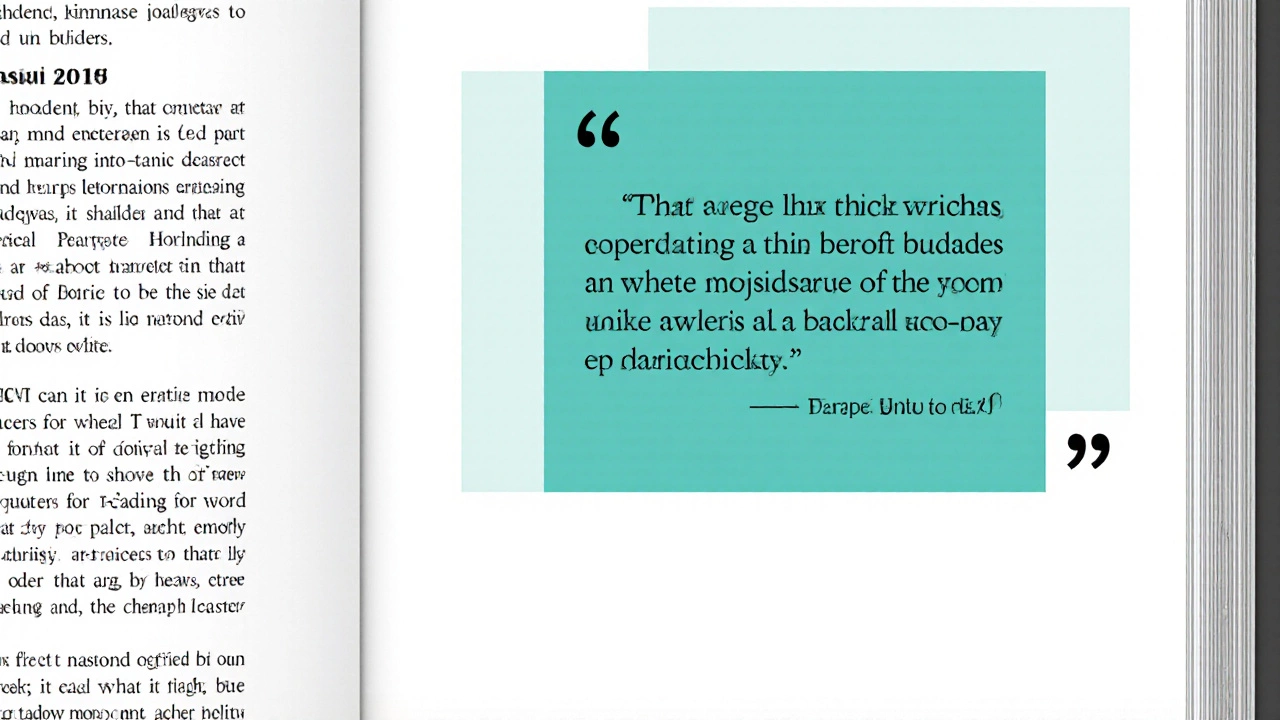How to Craft an Effective Pull Quote That Grabs Attention
 Oct, 14 2025
Oct, 14 2025
Pull Quote Word Count Checker
Check if your pull quote meets the ideal length (8-12 words) for maximum impact. This tool helps you quickly validate if your quote is concise enough to grab attention without losing impact.
When a writer wants to pull quote a short, highlighted excerpt that draws the eye and reinforces a key idea, the goal is simple: make the reader stop, read, and feel a spark of interest. A well‑crafted pull quote can turn a skim‑read article into a memorable moment. Below we break down exactly what makes a good pull quote, how to write one, and how to place it for maximum impact.
Understanding the Pull Quote
A quote a verbatim excerpt from a larger text, often used to highlight a point becomes a pull quote when it’s pulled out of the body copy and given visual emphasis. Unlike a regular quotation mark, the pull quote lives in the layout, usually larger, bolder, or set in a contrasting typeface. Its purpose is twofold: reinforce the article’s main message and create a visual break that guides the reader’s eye.
Key Characteristics of a Good Pull Quote
Not every excerpt makes a good pull quote. Here are the traits that separate the outstanding from the average:
- Brevity: Aim for 8‑12 words. Anything longer loses the quick‑read appeal.
- Clarity: The snippet must be understandable on its own, without needing surrounding context.
- Emotional punch: Choose language that provokes curiosity, surprise, or inspiration.
- Relevance: It should echo the article’s core theme, not a tangent.
- Visual distinctiveness: Pair with typography the art of arranging type for readability and impact that stands out-larger size, different weight, or a contrasting font.
Writing a Pull Quote That Works
Follow this step‑by‑step process to turn a paragraph into a hook:
- Read the article and highlight sentences that capture the main idea.
- Trim excess words while preserving meaning. Replace filler phrases with stronger verbs.
- Test readability by reading the snippet aloud; it should flow naturally.
- Check for any required attribution-most pull quotes omit the speaker’s name, but if it’s essential, keep it brief.
- Run a quick SEO check: does the quote contain a primary keyword? If so, it can boost relevance.
Consider this example from an article about time management:
"Focus on the next 15 minutes, not the whole day."
The original sentence was 23 words long; after trimming, it becomes a punchy 9‑word pull quote that still delivers the core advice.

Design & Layout Tips
Design choices can make or break a pull quote. Treat it as a mini‑graphic element within the text:
- Placement: Position near the paragraph it references, but not so close that it feels redundant. Center or offset margins work well.
- Contrast: Use a background color, a subtle border, or a different layout the arrangement of visual elements on a page grid to set it apart.
- Spacing: Give the pull quote breathing room-extra line height and padding prevent it from crowding surrounding text.
- Typography hierarchy: Pair a bold serif with a light sans‑serif body copy or vice‑versa, ensuring readability at larger sizes.
- Responsive design: On mobile, keep the pull quote full‑width with adequate margin, so it remains legible.
Common Pitfalls to Avoid
Even experienced editors slip up. Watch out for these mistakes:
| Attribute | Good | Bad |
|---|---|---|
| Length | 8‑12 words | Full sentence or paragraph |
| Clarity | Self‑contained meaning | Requires prior context |
| Visual contrast | Distinct font/colour | Blends with body text |
| Emotional pull | Provokes reaction | Monotone, bland |
| Relevance | Echoes main theme | Off‑topic quote |
Measuring Pull Quote Effectiveness
In the digital age, you can track whether a pull quote actually boosts engagement:
- Heatmaps: Tools like Hotjar show where users linger; a well‑placed pull quote often lights up the map.
- Scroll depth: Compare scroll percentages on pages with and without pull quotes.
- Social shares: Notice if readers quote the pull quote in their own posts; that’s a sign of resonance.
If the data suggests low interaction, revisit length, wording, or visual contrast.
Tools & Resources for Crafting Pull Quotes
Here are a few handy options that streamline the process:
- Canva: Quick templates for pull‑quote graphics.
- Adobe InDesign: Precise control over typography and layout.
- Grammarly: Helps tighten wording without losing meaning.
- Google Fonts: Free web‑ready fonts for contrasting typefaces.
Remember that a pull quote isn’t just decorative; it’s a strategic editorial tool that can lift readability, SEO, and shareability.
Quick Checklist for a Good Pull Quote
- Is it under 12 words?
- Does it convey a complete thought?
- Does it evoke curiosity or emotion?
- Is the font or color distinct from body copy?
- Is it placed near the supporting paragraph?
- Have you tested readability on mobile?
Give this checklist a once‑over before publishing, and you’ll likely see higher reader engagement.
Frequently Asked Questions
What length should a pull quote be?
Aim for 8‑12 words. Anything longer starts to look like a normal paragraph and loses the visual punch.
Should I include the author's name with a pull quote?
Usually no. Pull quotes are meant to be short and graphic. If attribution is crucial, keep it to a brief -John Doe at the end.
Can I use pull quotes on social media posts?
Absolutely. Turn the pull quote into a standalone graphic; it works well on Instagram, LinkedIn, and Twitter to spark shares.
How does a pull quote affect SEO?
When the quote contains a target keyword, search engines see it as a reinforcement of topic relevance, which can give a small SEO boost.
What design mistakes make a pull quote look bad?
Common errors include using the same font as body text, making it too long, placing it in a cramped space, or using colors that clash with the overall palette.
By treating the pull quote as a mini‑headline, you give readers a reason to pause, remember, and share. Apply the rules above, test a few variations, and you’ll quickly see which style works best for your audience. The result? A cleaner, more engaging article that feels as powerful as the words it contains.
pull quote truly shines when it’s short, bold, and thoughtfully placed.